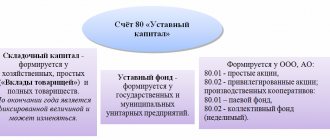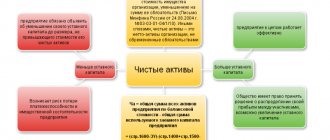Report writing rules
This report has a unified standard form recommended for use. The form can be expanded and supplemented based on the needs of the enterprise. The document contains:
- Company details,
- detailed information on the movement of three types of capital:
- additional,
- reserve,
- statutory,
- data on the share of the company's own shares,
- adjustments caused by changes in the company's accounting policies,
- information on changes in the amount of retained income and uncovered losses of the organization, etc.
Also, the report must be signed by the head of the company indicating the date of its preparation.
When filling out the form, special attention should be paid to the following points: information on changes in capital must be entered both for the last reporting period and for the two previous ones.
In addition, when drawing up a report, we must not forget that subtracted or negative values are entered in parentheses, and the units of measurement can be either millions or thousands of rubles.
Today, a report can be created and submitted to the Federal Tax Service in electronic or paper form.
You cannot make mistakes in this document, so after filling it out you need to check it very carefully and, if some inaccuracy or oversight does occur, it is better to fill out a new form.
Composition and structure of the report
The document is divided into 3 parts, each of which has a tabular form. Despite the fact that there are established sample forms for reporting, an enterprise can independently edit the document until it obtains the desired form. Nevertheless, it must consistently contain information by section:
- I – “Movement of capital”.
- II – “Adjustments due to changes in accounting policies and corrections of errors.”
- III – “Net assets”.
The contents of the statement of changes in capital fully reflect events occurring with the enterprise's own sources. The first section is devoted to the capital structure and transactions carried out with it. The second consists of at least three, and if it is necessary to reflect changes in other items of capital, then more parts. The third section contains information on the values at the end and beginning of the period of net assets. The statement of changes in capital (Form 3) must be drawn up on the basis of data for 3 years: the reporting year and the two preceding it.
Example of filling out a statement of changes in capital
We draw up the “header” of the document
First, the report indicates the year for which it was compiled (i.e. reporting period ). Next, enter the full name of the organization and the following data:
- date of registration,
- OKPO code (All-Russian Classifier of Enterprises and Organizations),
- TIN,
- type of economic activity (required in the form of an OKVED code and decoding).
Below is the organizational and legal status and form of ownership , and next to it are the OKOPF (All-Russian Classifier of Organizational and Legal Forms) and OKFS (All-Russian Classifier of Forms of Ownership) codes. The last line of the document header indicates OKEI (All-Russian Classifier of Units of Measurement) codes: i.e. thousands or millions of rubles used in the report.
Completing Section 1 of the Statement of Changes in Capital
The first part includes information:
- on the movement of three types of capital of the company: additional, reserve and authorized,
- information about shares owned by the company and acquired from holders,
- as well as income (undistributed) and losses (uncovered).
If the organization has existed for a long time, then data must be entered for the previous three years, but if the company was opened recently, then only for the last reporting period.
Under the code values, the reasons that contributed to the change in capital are written in the lines, and in columns 3 to 8 - its articles.
Line 3100 shows the balance of the accounting accounts. accounting from 80 to 84 (inclusive). Data from three years ago is recorded here.
Further, in lines 3200 to 3240, information for the previous year is shown in the same way. After this, the necessary information is entered into line 3210 (below is the distribution of all financial and economic actions that led to an increase in capital in the previous year).
Column 3 shows the increase in the authorized capital , in particular, cells 3210 - the full size of the increase, and cells from 3211 to 3216 reflect the channels through which it occurred (in accordance with the 80th accounting account).
Column 4 shows the price of acquired shares for joint stock companies or, for limited liability companies, parts in the authorized capital of the enterprise
Column 5 is information about the increase in additional capital (source: accounting account 83), and column 6 is information about reserve capital (from accounting account 82).
Column 7 contains information about the increase in profit or loss , compiled from net profit (loss), which remained after transferring taxes and creating reserve capital (based on the values of the 84th accounting account).
Column 8 summarizes the data for all rows in the section in question.
Next come row cells from 3220 to 3227.
- Line 3220 shows the values for the reduction of capital for all indicators of economic activity.
- Lines from 3221 to 3227 broadcast debit turnover according to accounting. accounts 80-84 (inclusive) and are filled in completely identical to the ones above.
Code values of lines 3230 and 3240 show changes in the financial parameters of two types of capital: reserve and additional.
Line 3200 reflects the full value of the company's capital as of the closing day of the year preceding the reporting period, compiled as a credit balance (according to accounting accounts 80-84 (inclusive)).
Then the data for the reporting year is recorded and, in the same way as for the previous year, lines from 3310 to 3340 are filled in. Information about the increase and decrease of capital is given here, the final annual value of capital is entered in line 3300.
Completing Section 2 of the Statement of Changes in Capital
The second part of the report shows corrected values and adjustments for the amounts of profits, losses and other indicators that arose as a result of changes in accounting policies.
Thus, if there were no changes in this part in the company’s work, and no errors were identified in previous periods of the report, then this section can be left blank.
If they were, then briefly about how to fill them out:
- in the third column enter the total cost of capital of the organization as of the end of the three-year period;
- line 3400 records the amount compiled before the changes,
- line 3500 - already corrected values;
- Below are lines that detail all the changes that have occurred.
Instructions for filling out line by line
It is possible to prepare reports by hand, using a computer or specialized accounting programs - this is the procedure for filling out a statement of changes in capital by line for 2020. Be sure to check the arithmetic operations before sending the report, check the data in Form No. 3 with the balance sheet and its appendices.
Let's look at the procedure for filling out items in the statement of changes in capital using a specific example.
Conditions for drawing up the reporting form:
- at the end of each year, Vesna LLC revalued its assets;
- as of December 31, 2019, account 81 shows the share of the participant who left the company transferred to Vesna LLC;
- in 2020, a significant error from 2020 was corrected, which was identified after the approval of the financial statements for 2018;
- no changes were made to the company's accounting policies during the reporting period.
Step No. 1. Fill out the report header
We indicate the name of the organization. We enter the type of economic activity, legal form and form of ownership. We separately designate the unit of measurement used when drawing up the document. In the tabular section of the document header we record the reporting date and registration codes:
- OKUD - 0771004;
- OKPO;
- TIN;
- OKVED 2;
- OKOPF and OKFS;
- OKI code.
Step No. 2. Section No. 1 “Movement of capital”
We fix the values corresponding to the previous reporting period: filling out the statement of changes in capital according to the lines of 2019, we begin with line 3100:
- page 3100 - enter the amount of the CCM balance as of January 1 of the previous year. We include the information in the appropriate column of the table by type of company's CCM;
- p. 3210 - we record an increase in the SCM. We detail the information on specific types of growth: depending on the reason for the growth (lines 3211-3216);
- p. 3220 - we register the decrease in the SCM in a similar order (lines 3221-3227);
- line 3230 - indicate the recorded changes in additional capital;
- page 3240 - enter changes in reserve capital.
Now we will detail the information on the indicators of the reporting year. In line 3200 we indicate the value as of December 31 of the previous year. We open lines 3310-3340 by analogy with the data of the previous time. In line 3300 we indicate the capital balances by type as of December 31 of the reporting year.
Step No. 3. Section No. 2 “Adjustments”
The second section discloses information about CCM adjustments. Line by line filling:
- line 3400 of the statement of changes in capital reflects indicators without adjustments;
- line 3401 - data before changes in retained earnings;
- line 3402 - indicator for other types of capital before the change;
- lines 3410, 3411, 3412 - adjustments caused by adjustments to accounting policies;
- lines 3420, 3421, 3422 - adjustments due to the correction of errors found;
- line 3500 reflects the indicator obtained after adjustments; including line 3501 - in terms of retained earnings and line 3502 - in terms of other types of financial capital.
The second section of the report reveals the indicators at the end of the previous previous year, changes in the previous period and at its end.
Characteristics of the values of some report lines
Income and expenses that are directly related to an increase (decrease) in capital are not included in the financial result of the enterprise. Their value is attributed in the case of income to line 3213 (3313), and in the case of expenses - to line 3223 (3323) of the statement of changes in capital.
The values of the capital reduction lines are indicated in parentheses, since the values change the capital downwards. Line 3227 (3327) contains information about the amount of profit that was distributed among the founders.
After the data in the first section has been successfully entered into the document, it is necessary to calculate the sum of all values. It is worth considering that the value in brackets must be subtracted from the result. The total values must coincide with the data indicated in the balance sheet (Section III).
Forms and report forms
Unified forms
financial statements for economic entities of Russia are approved by Order of the Ministry of Finance
of the Russian
No. 66n, which includes the so-called
form
No. 3 (OKUD 0710003).
For this type of reporting, two forms are presented. Let's look at how to fill out the statement of changes in equity.
1. Report
about changes
in capital
- a form with line codes that must be filled out when sent to the regulatory authorities.
2. Another option
a form without line-by-line codes, which is used within an economic entity, for example, by management.
Please note that Form No. 3 is not mandatory for all economic entities. Thus, the statement of changes in equity
, who must take the test is determined in Order of the Ministry of Finance No. 66n.
These include organizations that carry out accounting using the main method. But small
business companies that maintain simplified accounting may not submit these reports.









